Oral presentations and abstracts
Despite its satellite status, Titan has nothing to envy to planets: it has planetary dimensions, a substantial and dynamic atmosphere, a carbon cycle, a variety of geological features (dunes, lakes, rivers, mountains…), seasons and a hidden ocean. It even now has its own mission: Dragonfly, selected by NASA in the frame of the New Frontiers program.
In this session, scientific presentations are solicited to cover all aspects of current research on Titan: from its interior to its upper atmosphere, using data collected in the frame of the Cassini-Huygens mission (2004-2017) or from ground-based telescopes (e.g., ALMA) or based on modelling and experimental efforts to support the interpretation of past and future observations of this unique world.
Session assets
Titan has a thick atmosphere, the top of which is ionized and interacts with its plasma environment, i.e. usually the Saturnian magnetospheric plasma, but occasionally the magnetosheath or even the solar wind plasma. When the upstream plasma flow encounters Titan, the plasma slows down and diverts around Titan, and the magnetic field slowly diffuses into Titan’s ionosphere and induces currents in the ionosphere. The resulting magnetic field pattern is that, in the upstream of Titan, field lines drape around it, and in the downstream, the field lines stretch tail-like. Gradually these external fields penetrate into the lower atmosphere and the interior of Titan, and induce currents in any conductive layer if a conductive layer does indeed exist in Titan’s interior. This internally induced current acts to exclude the penetrated field. Both the internally induced field and the externally induced ionospheric field have strength and orientation variable with certain time scales because they are responses to the penetrated external field. The Cassini observations are a sum of fields from both internal and external sources. In this paper, we review the low altitude observations from all Cassini Titan flybys and examine the different behaviors of the external and internal fields, which ultimately provide an upper limit to Titan’s internal field leading to indications for Titan’s interior.
How to cite: Wei, H., Russell, C., Ma, Y., and Dougherty, M.: The external and internal magnetic fields of Titan: Cassini observations, Europlanet Science Congress 2020, online, 21 Sep–9 Oct 2020, EPSC2020-79, https://doi.org/10.5194/epsc2020-79, 2020.
The Cassini Langmuir Probe (LP) data acquired in the ionosphere of Titan are re-analysed to finely study the electron behaviour in the birthplace of Titan’s aerosols (900-1200 km). The detailed analysis of the complete Cassini LP dataset below 1200 km (57 flybys) shows the systematic detection of 2 to 4 electron populations, with reproducible characteristics depending on altitude and solar illumination. Their densities and temperatures are deduced from the Orbital Motion Limited theory. Statistical correlations with other quantities measured by Cassini are investigated. We finally discuss the origins of the detected populations, one being possibly emitted by aerosols.
1- Introduction
The Cassini mission discovered that Titan’s ionosphere is the birthplace of the solid orange aerosols surrounding Titan [1]. It is an ionized environment (plasma) hosting a complex ion chemistry [2]. The aerosols are formed and certainly eroded [3] in this environment. They are likely to interact strongly with the plasma species (i.e. electrons, ions, radicals and excited species): the ionosphere of Titan is a ‘dusty plasma’ below ~1100 km [4], [5]. Besides, models of the ionosphere do not match well measurements below 1100 km [6]. Recent works [7]–[9] showed the necessity to take negative ions and aerosols into account in the models.
The present work aims to finely analyse the behaviour of electrons in the aerosols-containing region of the ionosphere (~900-1200 km) sounded at 57 occasions by the Cassini Langmuir Probe (LP), part of the Radio and Plasma Wave Science (RPWS) package.
2- Re-analysis using 2 to 4 electron contributions
The current collected by the Langmuir probe in the conditions of the ionosphere of Titan can be modelled according to three hypotheses: (1) the electron velocity distributions are considered Maxwellians; (2) in the case where the probe repels electrons, the current collected can be given by the Orbital Motion Limited (OML) theory [10], [11]; (3) in the case where the probe attracts electrons, the current is fitted using the Sheath Limited theory [12].
To obtain a satisfactory fitting, we show the necessity of using 2 to 4 electron populations (named P1, P2, P3 and P4) at different potentials [13]. We observe (see Figure 1) that the second derivative of the current is useful to deduce the number of electron populations detected on a measurement and gives an idea of their relative proportions. Indeed, d²I/dU² is physically related to the electron energy distribution functions (EEDF) through the Druyvesteyn method [14].
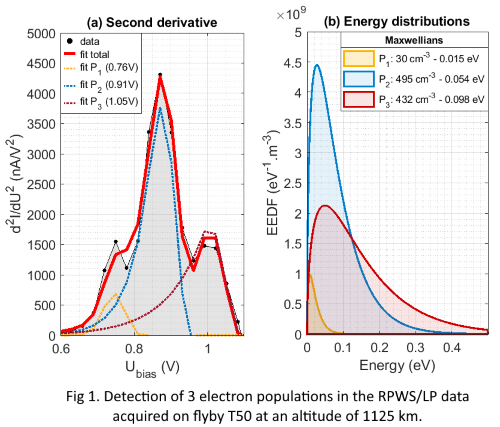
3- Populations: strong dependence with SZA and altitude
The visualisation of electron populations with d²I/dU² is used in Figure 2 to show the variations of the populations with altitude and solar illumination. Populations P1 and P2 are always present, contrarily to P3 and P4. Due to their low density and low potential, P1 electrons are suspected to be photo-electrons [10] or secondary electrons emitted on the probe stick. P3 electrons are only absent on the far nightside, while P4 electrons are detected only on dayside, and below the altitude of 1200 km. For this reason, they are suspected to be related to aerosols or heavy negative ions that appear below 1200 km.
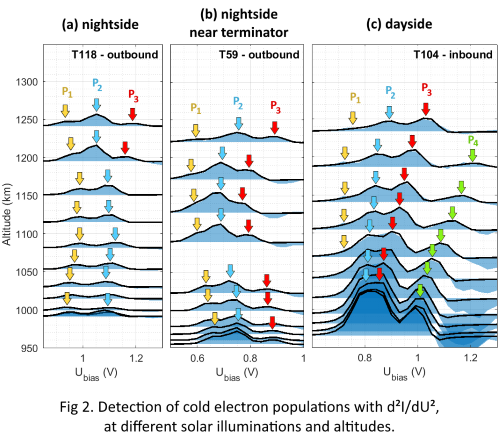
4- Densities and temperatures for all the electron populations
Figures 3 and 4 give statistics on electron densities and temperatures measured for all the populations for the 57 Cassini flybys reaching at least 1200 km. They show that electron temperatures do not vary much with altitude between 1200 and 950 km, except for P4. P3 and P4 have increasing densities with pressure on dayside.
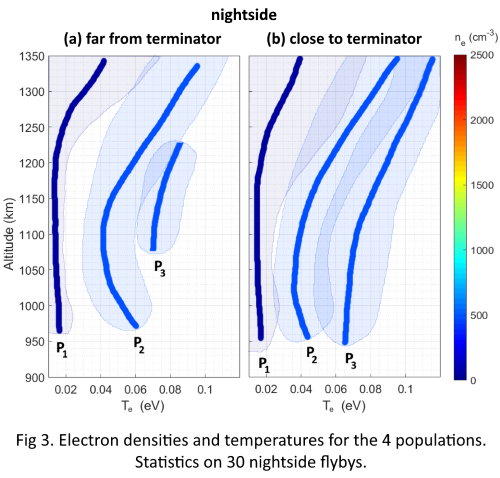
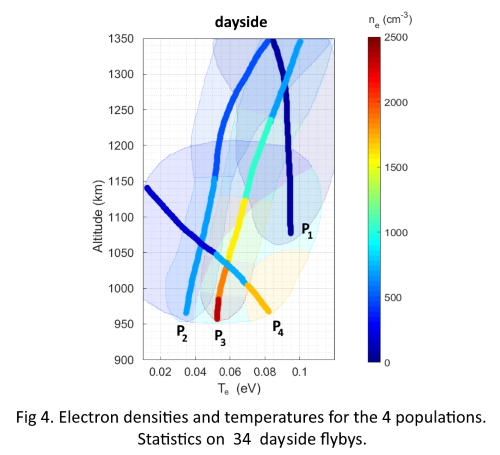
5- Statistics
The large dataset enables to do statistics and search for correlations. In particular, we observe that P3 and P4 densities are correlated with the extreme UV flux. This enforces the idea that these populations are formed by processes involving solar photons (certainly UV).
We also observe a strong correlation between the density and the temperature of the P4 population, as illustrated in Figure 5.

6- Conclusion: origins of the detected electron populations
From the above results we suggest possible origins for the three populations P2, P3 and P4, coming from the plasma surrounding the probe:
-P2 is detected in all cases, at rather low density (~500 cm-3) and temperature (~0.04 eV). These are supposed to be background thermalized electrons, possibly formed through collisions of gas species with magnetospheric suprathermal electrons.
-P3 electrons are denser with stronger solar illumination and higher pressure (up to 3000 cm-3). They are hotter than P2 electrons (~0.06-0.07 eV). Therefore, they could be formed by the photo-chemistry occurring in Titan’s ionosphere.
-P4 electrons are only observed on dayside and below 1200 km, in the place where heavy negative ions and aerosols are present. We suggest two possible formation processes: (1) the photo-emission of electrons from grains could be triggered by photons of a few eV due to the negative charge born by the aerosols [5], [15]; (2) electrons could also be thermo-emitted from the grains, as a result of their heating by diverse processes such as heterogeneous chemistry, sticking of electrons or recombination of radicals [16].
References
[1] J. H. Waite et al. Science 316 (2007)
[2] V. Vuitton et al. Icarus 324 (2019)
[3] A. Chatain et al. Icarus 345 (2020)
[4] P. Lavvas et al. PNAS 110 (2013)
[5] O. Shebanits et al. J. Geophys. Res. Sp. Phys. 121 (2016)
[6] M. Galand et al. in Titan, Cambridge University Press (2014) pp. 296–361.
[7] O. Shebanits et al. Astrophys. J. 850 (2017)
[8] R. T. Desai et al. Astrophys. J. 844 (2017)
[9] A. Wellbrock et al. Mon. Not. R. Astron. Soc. 490 (2019)
[10] J. E. Wahlund et al. Planet. Space Sci. 57 (2009)
[11] E. C. J. Whipple, PhD thesis, Georg. Washingt. Univ. (1965)
[12] R. T. Bettinger and E. H. Walker, Phys. Fluids 748 (1965)
[13] A. Chatain et al., “Electron temperature(s) in Titan’s ionosphere” in EPSC-DPS Joint Meeting (2019)
[14] M. J. Druyvesteyn, Zeitschrift für Phys. 64 (1930)
[15] S. Tigrine et al. Astrophys. J. 867 (2018)
[16] A. Woodard et al. J. Vac. Sci. Technol. A 38 (2020)
How to cite: Chatain, A., Wahlund, J.-E., Shebanits, O., Hadid, L., Morooka, M., Edberg, N., Carrasco, N., and Guaitella, O.: Re-analysis of the Cassini RPWS/LP data in Titan ionosphere: electron density and temperature of four cold electron populations, Europlanet Science Congress 2020, online, 21 Sep–9 Oct 2020, EPSC2020-436, https://doi.org/10.5194/epsc2020-436, 2020.
Abstract
Data from the Cassini Plasma Spectrometer Ion Beam Spectrometer (CAPS IBS) sensor have been examined for 5 close encounters of Titan during 2009 to examine heavy positive ions. Positive ions with masses between 170 and 310 u/q are examined. Ion mass groups are identified up to 275 u/q with ion groups below 250 u/q having clear structure with a 12-14 u/q spacing between group peaks.
The ion group peaks are found to be consistent with masses of polycyclic aromatic hydrocarbon (PAH) and polycyclic aromatic nitrogen heterocyclics (PANH). The ion groups in this study are the heaviest positive ion groups examined so far from in-situ ion data at Titan. Our findings further the understanding of the link between low mass ions and high mass negative ions, as well as the formation of aerosols in Titan's atmosphere.
Introduction
Titan is the largest moon of Saturn and has a thick extended atmosphere along with a large ionosphere. The ionosphere has been shown to contain a plethora of hydrocarbon/nitrile cations and anions1.
Previous ion composition studies in Titan’s ionosphere by Cassini instruments revealed "families" of ions around particular mass values and a regular spacing of 12 to 14 u/q between mass groups2. These are thought to be related to a carbon or nitrogen backbone that dominates the ion chemistry2. Previous studies also identified possible heavy ions such as naphthalene, anthracene derivatives and an anthracene dimer at 130, 170 and 335 u/q respectively1. Later flybys demonstrated the existence of even larger positive ions up to masses of 1100 u/q3.
Methodology
The Cassini Plasma Spectrometer Ion Beam Spectrometer (CAPS IBS)4 is an electrostatic analyser that measures energy per charge ratios of ions. During the Titan flybys Cassini had a high velocity (~6 km/s) relative to the low ion velocities (<230 m/s) observed in the ionosphere. The ions were also cold, having ion temperatures around 150K. The combination of these factors meant that the ions appeared as a highly-directed supersonic beam in the spacecraft frame. This means the ions appear at kinetic energies associated with the spacecraft velocity and the ion mass, therefore the measured eV/q spectra can be converted to u/q spectra.
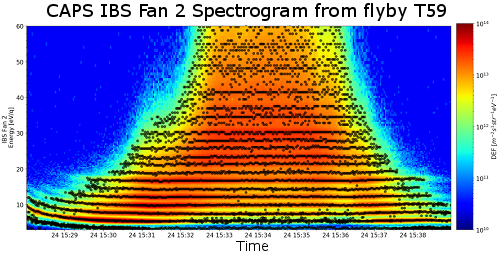
Figure 1 – A time-energy spectrogram showing the data obtained using CAPS IBS during the T59 flyby on 24th July 2009. Time is displayed on the x-axis, energy on the y-axis and intensity shown in the colour. Overlaid with dots are identified peaks in the energy spectra.
Results and Conclusions
Positive ions with masses between 170 and 300 u/q have been examined during five flybys of Titan performed by Cassini during 2009. Ion groups up to 275 u/q are found, representing molecular ions with up to 21 heavy (carbon/nitrogen/oxygen) atoms. Up to 250 u/q a regular spacing of 12 to 14 u/q between the most abundant ions is found, indicating a carbon or nitrogen backbone. Between 275 and 310 u/q, several prominent peaks are found but with no associated group structure. Peaks identified up to 275 u/q have masses consistent with cations deriving from multiple fused ring structures such as PAHs and PANHs and contain 3, 4 or 5 fused rings. Some of the peaks observed between 275 and 310 u/q are consistent with 5 and 6 ringed structures.
Previous work has identified a strong emission at 3.3µm that can be fitted using spectra from several neutral PAHs and PANHs5. The fitted neutrals are compared with the ion peaks and the peaks are found to appear at similar masses to the fitted neutrals. This implies there is coupling between the ion and neutral phases at these masses.
These are the largest distinct positive ion groups reported so far in Titan's ionosphere. The discovery of these groups will aid future atmospheric chemical models of Titan through identification of prominent heavy positive ions, aiding understanding of which reaction pathways are plausible to create the previously found heavy negative ions, neutrals and aerosols.
References
How to cite: Haythornthwaite, R., Coates, A., Jones, G., Wellbrock, A., and Waite, H.: Heavy positive ion groups in Titan's ionosphere: Cassini Plasma Spectrometer IBS observations, Europlanet Science Congress 2020, online, 21 Sep–9 Oct 2020, EPSC2020-671, https://doi.org/10.5194/epsc2020-671, 2020.
The Cassini spacecraft observed Titan’s upper atmosphere and its airglow emissions from 2005 to 2017. It is now established that the solar XUV radiation is the main source of dayglow, while magnetospheric particle precipitation principally acts on the nightside of the satellite. Nevertheless, one of the questions remaining unanswered after the end of the Cassini mission concerns the role and quantification of the magnetospheric particle precipitation and other minor sources such as micrometeorite precipitation and cosmic galactic ray at Titan. We report here on enhancements observed in Ultraviolet (UV) observations of Titan airglow made with the Cassini-Ultraviolet Imaging Spectrograph (UVIS). Enhancements are correlated with magnetospheric changing conditions occurring while the spacecraft, and thus Titan, are known to have crossed Saturn’s magnetopause and have been exposed to the magnetosheath environment. The processing and interpretation of 13+ years of airglow observations at Titan allows now for global studies of the upper atmosphere as a function of the Saturn Local Time (SLT) and the solar cycle.
Nitrogen airglow occur at about 1100 km of altitude in Titan’s upper atmosphere. Observations by the Cassini-UVIS instrument revealed the emission of the LBH band system, VK band system as well as Nitrogen atomic emission lines at 1085Å and 1493Å, as the prominent features of airglow emissions at Titan, as shown in Figures 1 and 2. Measurements were made at a wide range of solar incidence angles and Saturn Local Time (SLT), during the entire Cassini mission, allowing for the investigation of the upper atmosphere response to the magnetospheric environment and energetic particle precipitation. Additionally, observations were taken in a variety of solar condition, from solar maximum to minimum. UVIS observations of Titan around 12PM SLT (near Saturn’s magnetopause) present evidence of Titan’s upper atmosphere response to a fluctuating magnetospheric environment.
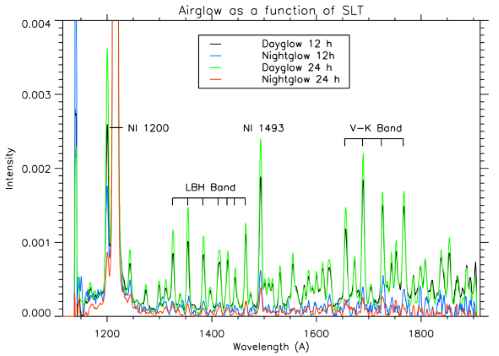
Figure 1. Airglow intensity as a function of the saturn Local Time (SLT), for observation taken close the Saturn’s magnetopause (12PM SLT, labelled ‘12h’) and observations taken around miadnight SLT (labelled ‘24h’). Dayglow spectra exhibit higher averaged airglow intensity than Nightglow spectra.
We present here comparisons of the spectral emissions from the dayglow (Solar incidence angle <110°) and nightglow (Solar incidence angle ≥110°) between a rayheight of 900-1200 km around noon (±1 h) and around midnight (±1 h) SLT, during solar minima and maxima conditions (Fig. 2). Results show an enhancement of the airglow brightness with increasing particle precipitation, especially at SLT close to noon (i.e. close to the magnetopause), during solar maximum and minimum. Correlation between the ratio of the V-K, LBH, and NI-1493Å emission peaks are also presented.
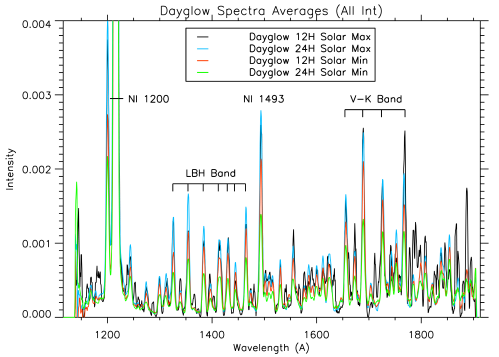
Figure 2. Dayglow intensity as a function of the saturn Local Time (SLT) and solar cycle. Observations have been dispatched in four groups as a function of Titan’s orbital position within Saturn’s magnetosphere and maximum oe minimum stage of the solar cycle. Results suggest that solar maximum conditions around midgnight SLT favor the apparition of the brightest dayglow.
In the past decade, results from the Cassini-UVIS instrument greatly improved our understanding of airglow production at Titan. However, combining remote-sensing datasets, such as Cassini-UVIS data, with in-situ measurements taken by the Cassini Plasma Spectrometer (CAPS) instrument can provide us with a more rigorous assessment of the airglow contribution and correlations between data from simultaneous observations of in-situ Cassini instruments (CAPS, RPWS and MIMI) has been possible on few occasions. UVIS results present here will be put in context with results from in-situ simultaneous observations.
How to cite: Royer, E., Cooper, M., Ajello, J., Esposito, L., and Crary, F.: Titan’s Ultraviolet Airglow Variability with Solar Cycle and Saturn Local Time, Europlanet Science Congress 2020, online, 21 Sep–9 Oct 2020, EPSC2020-415, https://doi.org/10.5194/epsc2020-415, 2020.
Abstract:
Using spectrally and spatially resolved observations of Titan made with the Atacama Large Millimeter/submillimeter Array (ALMA) in August 2016 and May 2017, we obtained global snapshot maps of emission lines from atmospheric CH3CN, HC3N and HNC gases. High-altitude wind fields (in the altitude range ~300-1000 km) were retrieved through Doppler mapping, confirming the existence of high-velocity superrotating zonal winds on Titan, with speeds in the range 180-390 m/s near the equator (speeds increasing with altitude). At the highest, thermospheric altitudes probed by HNC, a ~50% reduction in the equatorial zonal wind speed was measured over the 9-month period covered by these observations. This is consistent with a dramatic slowing of the recently-discovered thermospheric equatorial jet. The implications of this result for our understanding of Titan's global circulation, and the forcing mechanisms impacting the uppermost atmosphere, will be discussed.
1. Introduction
Saturn's largest moon, Titan has an unusually thick, dense (1.45 bar) atmosphere comprised predominantly of molecular nitrogen and methane, subject to a complex atmospheric chemistry and seasonally-evolving pattern of winds and global circulation [1]. The presence of zonal winds on Titan was initially inferred from stellar occultation observations [2], and later confirmed by in-situ Doppler measurements during the descent of the Cassini-Huygens probe [3]. More recently, Lellouch et al. [4] took advantage of the extremently high sensitivity and resolution of the Atacama Large Millimeter/submillimeter Array (ALMA) to derive the first Doppler wind maps of Titan's thermosphere. An unexpectedly intense, superrotating equatorial jet was discovered at thermospheric altitudes (~1000 km), with a velocity of ~350 ms-1. Here we present new measurements of Titan's high-altitude wind field using ALMA observations from May 2017, compared with a re-analysis of the August 2016 data from Lellouch et al. [4].
2. Results
We used Gaussian fits to the observed sub-mm emission lines to determine line-of-sight velocities for the CH3CN, HC3N and HNC gases as a function of spatial coordinate across Titan. The resulting Doppler maps are shown in Figure 1, where the color of each pixel indicates the line-of-sight radial velocity, dominated by west-to-east (zonal) flow. The 2016 and 2017 ALMA data were convolved to a common (~1600 km) beam FWHM.

Due to their differing vertical abundance distributions, the observed gases preferentially emit from different altitudes on Titan. The CH3CN molecule emits most strongly in the upper stratosphere, whereas HC3N is sensitive to the mesophere/thermosphere, and HNC probes the highest, thermospheric altitudes (around 1000 km) [4]. In 2016, there was a clear trend for increasing equatorial zonal wind speed with altitude, which is less apparent in the 2017 data. The greatest temporal variation is for HNC, which showed a dramatic (~ factor of two) reduction in wind speed over the 9-month period between the two epochs: after correcting for the obliquity of Titan's polar axis, the mean, beam-averaged equatorial HNC wind speed was 294±10 ms-1 in 2016 and 159±7 ms-1 in 2017. Deconvolution with respect to the finite ALMA spatial resolution element is required in order to derive the true wind speeds as a function of latitude, which will be presented in a future article [5].
3. Conclusion
Capitalizing on the high sensitivity and resolution of ALMA, we have generated Doppler maps of three different molecules, from which Titan's zonal wind field was derived as a function of latitude, altitude and time, in the range ~300-1000 km (upper stratosphere to thermosphere). Rapid changes in wind speeds were observed over a 9-month period from 2016-2017, the most striking of which is a ~50% drop in the velocity of the recently-discovered thermospheric equatorial jet. In this presentation, we will focus on the detailed wind field variations as a function of altitude and will discuss their implications for our understanding of Titan's global circulation, and the dynamical coupling between the lower and upper atmosphere.
References:
[1] Horst, S. M. 2017, Journal of Geophysical Research (Planets), 122, 432
[2] Hubbard, W. B., Sicardy, B., Miles, R. et al. 1993, A&A, 269, 541
[3] Bird, M. K., Allison, M., Asmar, S. W. et al. 2005, Nature, 438, 800
[4] Lellouch, E., Gurwell, M. A., Moreno, R. et al. 2019, Nature Astronomy, 3, 614
[5] Cordiner, M. A, Garcia-Berrios, E., Cosentino, R. et al. 2020, in prep.
How to cite: Cordiner, M., Garcia, E., Cosentino, R., Teanby, N., and Nixon, C.: Temporal Variability of Titan’s High-Altitude Zonal Winds Detected using ALMA, Europlanet Science Congress 2020, online, 21 Sep–9 Oct 2020, EPSC2020-424, https://doi.org/10.5194/epsc2020-424, 2020.
In support of the Herschel Space Observatory and in the framework of the program “Water and Related Chemistry in the Solar System” [1], hydrogen cyanide (HCN) on Titan was observed from ground at submillimetre wavelengths. We carried submm heterodyne spectroscopy observations of HCN (4-3) at 345.5 GHz with the Atacama Pathfinder Experiment (APEX) and the APEX-2 heterodyne receiver, and of HCN (3-2) at 265.9 GHz with the Institut de radioastronomie millimétrique (IRAM) 30-m telescope (IRAM 30m) and the Heterodyne Receiver Array (HERA) receiver in Titan atmosphere. Observations were carried out on June 16, 2010, and March 19, 2011, under non-favorable and favorable weather conditions, respectively. We report here the APEX and IRAM 30m observations, and by using a line-by-line radiative transfer code and the least-squares fitting technique, the analysis to infer the HCN abundance. Our HCN mixing-ratio estimations confirm the result of Marten et al. (2002) [2]. We compare our results with the those with Herschel/PACS and SPIRE acquired during 2010 [3,4]. Measured HCN abundances on Titan with data acquired at different epochs and transitions exhibit similar abundance distributions. Beyond the intrinsic scientific interest, these observations proven their usefulness in supporting spacecraft observations of Solar System bodies, in particular, of Titan’s atmosphere.
[1] Hartogh, P.; Lellouch, E.; Crovisier, J., et al. 2009, Planetary and Space Science, Volume 57, Issue 13, p. 1596-1606. [2] Marten, A.; Hidayat, T.; Biraud, Y. et al. Icarus, 2002, Volume 158, Issue 2, p. 532-544. [3] Rengel, M.; Sagawa, H.; Hartogh, P., et al. 2014, A&A, 561. [4] Courtin, R., Swinyard, B. M., Moreno, R., et al. 2011, A&A, 536, L2.
How to cite: Rengel, M., Shulyak, D., Hartogh, P., Sagawa, H., Moreno, R., and Jarchow, C.: Observing atmospheric HCN on Titan from space and ground-based observatories: an inter-comparison study from Herschel, APEX and IRAM 30m telescopes , Europlanet Science Congress 2020, online, 21 Sep–9 Oct 2020, EPSC2020-570, https://doi.org/10.5194/epsc2020-570, 2020.
As in the case of the terrestrial atmosphere, the composition of the atmosphere of Titan is dominated by N2, with a mole fraction of 0.97. The second most abundant species, with a mean amount of 2.7%, is methane, CH4. Minor components include H2, Ar, higher hydrocarbons (C2H6, C2H2, C2H4), and nitriles (HCN, HCCCN). The NASA/ESA/ASI Cassini-Huygens mission provided us with much information about this interesting object of our Solar System, which revealed itself as the body with the most chemically active atmosphere, notwithstanding the global low temperature (94 K at the surface and up to ca. 200 K at high altitudes). Surprisingly, the richest chemistry occurs in the upper part of the atmosphere, from the stratosphere up to the thermosphere where the first haze layer is found. The first measurements of the ionosphere of Titan revealed a totally unexpected complex composition with positive ions as large as m/z = 350 and negatively charged ions with m/z up to 4000. In recent years, the atmosphere of Titan has become the object of further ground-based observations with the ALMA interferometer. Among the species identified by Cassini Ion Neutral Mass Spectrometer (INMS), benzene is characterized by a considerable mole fraction (for instance, at 950 km the mole fraction of benzene is 1.3 × 10−6). In the same range of altitude, molecular nitrogen is converted into N atoms or N+ /N2+ ions by the interaction with extreme ultra-violet (EUV) photons or by other energetic processes. In particular, N atoms are produced by N2 dissociation induced by electron impact/EUV photons or dissociative photoionization, galactic cosmic ray absorption, and N2+ dissociative recombination. All these processes lead to the formation of atomic nitrogen in its ground electronic state 4S3/2 and, in a similar amount, in the first electronically excited 2D3/2,5/2 states. The radiative lifetimes of the metastable 2D3/2,5/2 states are long enough (6.1 × 104 s and 1.4 × 105 s for the 2D3/2 and 2D5/2 state, respectively) to enable their chemical reactions in binary collisions with other constituents of the upper atmosphere. This specific aspect is crucial because it is known that nitrogen is significantly incorporated into the large N-containing organic species that form the orange aerosol covering Titan. Some of the present authors have already characterized the reactions of N(2D) with several aliphatic hydrocarbons (CH4, C2H2, C2H4, C2H6) which are abundant in the atmosphere of Titan [1-4]. Interestingly, in all the above-mentioned cases, the formation of products containing a novel C-N bond has been observed.
In this contribution, we extend our combined theoretical and experimental approach to the reaction involving N(2D) and small aromatics, namely benzene and toluene. In particular, we wish to establish whether the aromatic ring is preserved in this reaction (as in the case of other gas-phase reactions) and whether the N atom is incorporated in the ring of carbon atoms, forming pyridines, or their less stable isomers. Remarkably, by the analysis of the spectra recorded by the Cassini-INMS in the Open Source Ion mode the presence of a species with general formula C5H5N was inferred, indicating that either pyridine or one of its isomers is formed in the upper atmosphere of Titan starting from active forms of nitrogen.
The authors acknowledge funding from European Union’s Horizon 2020 Marie Skodowska-Curie project “Astro-Chemical Origins (ACO), grant agreement No 811312, and the Italian Space Agency for co-funding the Life in Space Project (ASI N. 2019-3-U.O).
[1] Balucani, N., Bergeat, A., Cartechini, L., Volpi, G.G., Casavecchia, P., Skouteris, D., Rosi, M.: Combined crossed molecular beam and theoretical studies of the N(2D) + CH4 reaction and implications for atmospheric models of Titan. J. Phys. Chem. A 113, 11138–11152 (2009)
[2] Balucani, N., Leonori, F., Petrucci, R., Stazi, M., Skouteris, D., Rosi, M., Casavecchia, P.: Formation of nitriles and imines in the atmosphere of Titan: combined crossed-beam and theoretical studies on the reaction dynamics of excited nitrogen atoms N(2D) with ethane. Faraday Discuss. 147, 189–216 (2010)
[3] Balucani, N., Skouteris, D., Leonori, F., Petrucci, R., Hamberg, M., Geppert, W.D., Casavecchia, P., Rosi, M.: Combined crossed beam and theoretical studies of the N(2D) + C2H4 reaction and implications for atmospheric models of Titan. J. Phys. Chem. A 116, 10467–10479 (2012)
[4] Balucani, N., Pacifici, L., Skouteris, D., Caracciolo, A., Casavecchia, P., Rosi, M.: A theoretical investigation of the reaction N(2D) + C6H6 and implications for the upper atmosphere of Titan. In: Gervasi, O., et al. (eds.) ICCSA 2018. LNCS, vol. 10961, pp. 763– 772. Springer, Cham (2018). https://doi.org/10.1007/978-3-319-95165-2_53
How to cite: Skouteris, D., Balucani, N., Caracciolo, A., Casavecchia, P., and Rosi, M.: The N(2D) reaction with small aromatic compounds and implications in the aromatic chemistry of the upper atmosphere of Titan , Europlanet Science Congress 2020, online, 21 Sep–9 Oct 2020, EPSC2020-445, https://doi.org/10.5194/epsc2020-445, 2020.
Abstract
In the atmosphere of Titan, Saturn's main satellite, molecular growth is initiated by a chemistry involving charged and free-radical species. However, the respective contribution of these species to the complexification of matter is far from being known. This work presents a chemical analysis by mass spectrometry at relatively low pressure to characterize the formation pathways of the first aromatics, notably benzene, by irradiating a mixture N2/CH4 with EUV photons.
Introduction
It is now accepted that photochemical processes in the atmosphere of Titan, the largest of Saturn's 62 moons, directly influence the chemical composition of the liquid lakes and the surface hydrological activity. Thus, a detailed understanding of the chemistry of Titan's atmosphere is the way forward to a whole Titan modeling. In the highest atmospheric layers between 700 and 1100 km in altitude, N2 and CH4 are ionized and dissociated mainly by energetic EUV photons from solar radiation, leading to the formation of reactive species like ions and radicals among a diverse range of species hydrocarbons, amines, and imines. In the lower layers of the atmosphere, below 500km, hydrocarbons such as benzene and other aromatics by interaction with lower energy UV photons (>155 nm) are key compounds in the formation of larger and more complex molecules like Polycyclic Aromatic Hydrocarbons (PAHs) and Polycyclic Aromatic Nitrogen Heterocycles (PANHs). These intermediate species between small organic precursor molecules and larger carbonaceous materials, contribute to the production of aerosols which form the opaque photochemical haze layers that obscure the surface of Titan. Thus the identification of the pathways of formation of these species is essential for understanding the chemistry of Titan's atmosphere, but is yet to be fully understood even for the simplest PAH, namely benzene (C6H6). In situ and direct observations are insufficient to constrain photochemical models and understand the molecular complexification pathways of Titan's atmosphere. Thus the way forward is to reproduce the chemistry in the laboratory by irradiating a mixture of gases representative of this environment from a photon-producing energy source.
Experimental Method
In this study a nonlinear optics approach has been used to generate intense and stable light in the Extreme Ultraviolet (EUV) because energetic photons are absorbed in the upper atmospheric layers and initiate the formation of reactive species in the satellite ionosphere. The EUV light was produced by the high-order harmonic generation of the femtosecond BLASBEAT laser at CELIA in Bordeaux and injected into the closed and removable SURFACAT photoreactor to irradiate for several hours, at a pressure of 0.1mbar, a gas mixture composed of nitrogen and methane (95/5%) at a wavelength of 85.58 nm. This wavelength falls within the energy range of interest between the CH4 dissociation threshold (98 nm) and the N2 ionization threshold (79.4 nm), which allows the production of nitrogen atoms in its ground and excited state that are suspected of playing a fundamental role in the molecular growth of complex but as yet unknown nitrogen species.
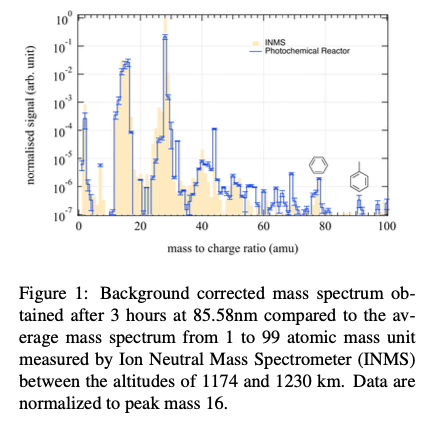
Results
The results presented in Figure 1, show overall a good agreement between the products formed in the photochemical reactor and the data obtained in situ in Titan's atmosphere. Especially, there is good agreement for the peak at mass 78 which has been identified as benzene in Titan's atmosphere. Because of the importance of benzene in Titan's atmosphere, this study is dedicated to analyze its formation pathways in the photochemical reactor and the implications for our understanding of the chemistry of Titan's atmosphere. At the wavelength used in this experiment, photolysis of methane leads mainly to the formation of the CH4+ ion with a branching ratio of 47% and methyl radical ion (CH3+) and methylidyne radical (CH) with branching ratios of 19% and 18% respectively. While the formation of CH4+ leads to a closed cycle of methane formation, CH3+ is a source of C2H5+ ions by reaction with methane. These ions recombine to lead mainly to the formation of highly reactive ethylenyl radicals (C2H3). By reacting with hydrocarbon radicals such as butadienyl (C4H3), they are at the origin of phenyl radicals (C6H5), precursor of benzene by addition of a hydrogen atom. At the wavelength used in this experiment, the other dominant photoproduct of methane photolysis, CH, leads mainly to the formation of C2H4, whose photolysis by energetic photons leads mainly to the formation of hydrocarbon ions C2H2+ and C2H3+. These ions then lead to the formation of propargyl radicals (C3H3) which by recombining give rise to the formation of benzene.
Implications for Titan's atmosphere
The literature points out that the production of benzene in the upper atmospheric layers of Titan is due to radical-radical reactions but mainly to the chemistry of the ions via the dissociative recombination of aromatic ions such as C6H6+ and C6H7+. In less energetic conditions, such as photons from solar radiation arriving on Titan, the photolysis of methane leads mainly to the formation of hydrocarbon radicals (CH2 and CH3) which will contribute to many small neutral hydrocarbons (C2H2, C2H4) that will form heavy ions and prevent electronic recombinations. However, the troubling overlap between the benzene signal in this EUV-dominated work and that of INMS shows that it is crucial to have a good assessment of the branching ratios of radical-radical reactions at low pressures and low temperatures representative of Titan's atmosphere. Especially, association reactions can be rapid even at low pressures for adducts of significant size. Indeed, the most energetic photons are absorbed in the upper atmospheric layers to initiate molecular growth while the less energetic photons are absorbed lower in the atmosphere. Additionally, the detection of a signal at mass 92 in Figure 1, could be assigned to toluene (C7H8) and signal at mass 91 to its main fragment due to electronic impact by the ionization of the mass spectrometer used in this work. It confirms the importance of a rigorous analysis of neutral reactions, since toluene can be formed by the reaction between phenyl and methyl radicals, which, although poorly understood, involves one of the precursors of benzene whose formation would be favored in an environment with energetic photons.
How to cite: Bourgalais, J., Carrasco, N., Vettier, L., Comby, A., Blanchet, V., Gaudin, J., Mairesse, Y., and Marty, B.: Neutral Aromatic Pathways Enhanced by EUV Irradiation in a Titan's Atmosphere Simulation Photochemical Experiment, Europlanet Science Congress 2020, online, 21 Sep–9 Oct 2020, EPSC2020-1036, https://doi.org/10.5194/epsc2020-1036, 2020.
Molecular nitrogen (N2) is the main component of the atmosphere of Titan, while minor constituents include organic molecules, such as methane and higher hydrocarbons [1,2]. Among them, propyne (methylacetilene) has been identified in the Voyager IR spectrum of Titan since 1981 [3], while its structural isomer propadiene (allene), already predicted to be present by photochemical models, has been only recently identified via the Texas Echelle Cross Echelle Spectrograph on the NASA Infrared Telescope Facility [4]. Given the presence of higher hydrocarbons, N-bearing organic molecules in trace amounts (nitriles and imines) and haze macromolecules, Titan has proved to be the object of the Solar System with the richest atmospheric chemistry. Understanding such complex chemistry requires a multidisciplinary approach based on the interaction between chemists and planetary scientists. In particular, the build-up of realistic photochemical models requires accurate estimates of reaction rate coefficients and product branching ratios. This has led several research groups working in the field of chemical kinetics to undertake systematic studies on gas phase reactions of relevance in the chemistry of Titan.
In our laboratory, we have used a combined experimental and theoretical approach to characterize the reactions involving atomic nitrogen in its first electronically excited state, 2D, and simple hydrocarbons [5-9]. N(2D) is produced in the thermosphere of Titan by several high-energy processes and, being a metastable state with a long radiative lifetime, is able to undergo reactive collisions before decaying by spontaneous emission of photons [10].
In this contribution, we report on a combined theoretical and experimental study of the reactions of N(2D) with the two structural isomers methylacetilene (CH3CCH) and allene (CH2CCH2). In many photochemical models, structural isomers are not distinguished and treated as only one species. However, we know that the reaction mechanism can be very different for each isomer leading to different final reaction products [11].
More specifically, the potential energy surfaces for the two reactions have been derived by performing electronic structure calculations at DFT and CCSD(T) level, while the reaction mechanism of the H-displacement channels have been investigated experimentally by the crossed molecular beam technique. Both the reactions start with a barrierless attack of the N atom to multiple bond of the molecules, leading to the formation of cyclic intermediates. Different isomerization processes can then lead to various product channels.
The implications for the chemistry of the atmosphere of Titan will be also addressed.
References
__________________________________
[1] G.F. Lindal et al., The Atmosphere of Titan. An analysis of the Voyager radio occultation measurements. Icarus 2 (53), 348-363 (1983).
[2] R.Hanel et al., Infrared Observations of the Saturnian System from Voyager 1. Science 212, 4491, 192-200 (1981).
[3] W.C. Maguire et al., C3H8 and C3H4 in Titan's atmosphere. Nature 292, 5825, 683-686 (1981).
[4] N.A. Lombardo et al., Detection of Propadiene on Titan. The Astrophysical Journal Letters 881, L33 (6 pp) (2019).
[5] N. Balucani et al., Combined Crossed Molecular Beam and Theoretical Studies of the N(2D)+CH4 Reaction and Implications for Atmospheric Models of Titan. The Journal of Physical Chemistry A 113, 11138–11152 (2009).
[6] N. Balucani et al., Cyanomethylene Formation from the Reaction of Excited Nitrogen Atoms with Acetylene: A Crossed Beam and ab Initio Study. Journal of the American Chemical Society 122, 4443-4450 (2000).
[7] N. Balucani et al., Formation of nitriles and imines in the atmosphere of Titan: combined crossed-beam and theoretical studies on the reaction dynamics of excited nitrogen atoms N(2D) with ethane. Faraday Discussions 147, 189-216 (2010).
[8] N. Balucani et al., Combined Crossed Beam and Theoretical Studies of the N(2D) + C2H4 Reaction and Implications for Atmospheric Models of Titan. The Journal of Physical Chemistry A 116, 10467-10479 (2012).
[9] N. Balucani et al., Observation of nitrogen-bearing organic molecules from reactions of nitrogen atoms with hydrocarbons: A crossed beam study of N(2D) + ethylene. The Journal of Physical Chemistry A 104, 5655–5659 (2000).
[10] O. Dutuit, et al, Critical review of N, N+, N2+, N++ and N2++ main production processes and reactions of relevance to Titan’s atmosphere. Astrophys. J. Suppl. Ser. 204, 20 (2013).
[11] G. Vanuzzo et al., Isomer-specific chemistry in the propyne and allene reactions with oxygen atoms: CH3CH + CO versus CH2CH2 + CO Products. The Journal of Physical Chemistry Letters 7, 1010-1015 (2016).
How to cite: Pannacci, G., Mancini, L., Rosi, M., Balucani, N., Skouteris, D., Valença Ferreira de Aragão, E., Vanuzzo, G., Marchione, D., Recio, P., Liang, P., Tan, Y., and Casavecchia, P.: The reactions of atomic nitrogen in its first electronically excited state with the C3H4 isomers and implications for the atmospheric chemistry of Titan, Europlanet Science Congress 2020, online, 21 Sep–9 Oct 2020, EPSC2020-725, https://doi.org/10.5194/epsc2020-725, 2020.
Titan, Saturn’s largest moon, has long been known to harbor a thick atmosphere [1] that evolves a complex array of organic molecules through atmospheric photochemistry [2, 3]. Especially from the 1970s onwards, successive waves of investigation with ground-based telescopes, spacecraft including Voyager 1 and Cassini-Huygens, and space telescopes have revealed the molecular inventory of its atmosphere through remote sensing at UV to radio wavelengths, and in situ mass spectroscopy [4, 5]. Since coming online in 2012, the ALMA (Atacama Large Millimeter/submillimeter Array) telescope has added importantly to our knowledge of Titan’s atmospheric composition, especially through first detections of propionitrile (ethyl cyanide, C2H5CN) and acrylonitrile (vinyl cyanide, C2H3CN) in the neutral atmosphere [6, 7]. Such new measurements are of vital importance for constraining photochemical models [8-10] and helping us unravel the steps to building even larger molecules and haze particles [11], with important repercussions for astrobiology [12].
In recent years we have continued the search for new molecules in Titan’s atmosphere, acquiring high-sensitivity observations with ALMA to search for larger hydrocarbons, nitriles and other species. In 2016 we acquired 129 mins of integration on Titan in ALMA Band 6 that exhibited many lines of C2H5CN (ethyl cyanide) and other known species. In addition we found several weak lines that we identified as c-C3H2 (cyclopropenylidene), a small cyclic molecule frequently seen in the interstellar medium [13, 14], but not previously seen in a planetary atmosphere. The spectrum was modeled using the NEMESIS radiative transfer and inversion computer model [15] yielding a best-fit mixing column abundance of 5.29x1012 molecule cm-2, somewhat greater than predicted by recent photochemical models (1.41x1012 [8]; 7.71x1011 [16]).
Cyclopropenylidene is now only the second cyclic molecule to be detected in a planetary atmosphere after benzene. Its measurement will provide vital constraints on the chemistry of important intermediate-size radicals such as C3H3 (propargyl and its isomers) whose chemistry may lead to either c-C3H2 (by hydrogen loss) or to benzene (e.g. by self-reaction). Ultimately, a better understanding of cyclic molecule chemistry will lead to a better understanding of haze formation, and Titan’s potential for astrobiology.
References
[1] G. P. Kuiper, "Titan: A satellite with an atmosphere," Astrophysical Journal, vol. 100, no. 3, pp. 378-383, Nov 1944, doi: 10.1086/144679.
[2] Y. L. Yung, M. Allen, and J. P. Pinto, "Photochemistry of the Atmosphere of Titan - Comparison Between Model and Observations," Astrophysical Journal Supplement Series, vol. 55, no. 3, pp. 465-506, 1984, doi: 10.1086/190963.
[3] Y. L. Yung, "An Update of Nitrile Photochemistry on Titan," Icarus, vol. 72, no. 2, pp. 468-472, Nov 1987, doi: 10.1016/0019-1035(87)90186-2.
[4] B. Bezard, R. V. Yelle, and C. A. Nixon, "The composition of Titan's atmosphere," (in English), Titan: Interior, Surface, Atmosphere, and Space Environment, Article; Book Chapter no. 14, pp. 158-189, 2014.
[5] S. M. Horst, "Titan's atmosphere and climate," Journal of Geophysical Research-Planets, vol. 122, no. 3, pp. 432-482, Mar 2017, doi: 10.1002/2016je005240.
[6] M. A. Cordiner et al., "ETHYL CYANIDE ON TITAN: SPECTROSCOPIC DETECTION AND MAPPING USING ALMA," Astrophysical Journal Letters, vol. 800, no. 1, Feb 10 2015, Art no. L14, doi: 10.1088/2041-8205/800/1/l14.
[7] M. Y. Palmer et al., "ALMA detection and astrobiological potential of vinyl cyanide on Titan," Science Advances, vol. 3, no. 7, Jul 2017, Art no. e1700022, doi: 10.1126/sciadv.1700022.
[8] V. Vuitton, R. V. Yelle, S. J. Klippenstein, S. M. Horst, and P. Lavvas, "Simulating the density of organic species in the atmosphere of Titan with a coupled ion-neutral photochemical model," Icarus, vol. 324, pp. 120-197, May 2019, doi: 10.1016/j.icarus.2018.06.013.
[9] K. Willacy, M. Allen, and Y. Yung, "A NEW ASTROBIOLOGICAL MODEL OF THE ATMOSPHERE OF TITAN," Astrophysical Journal, vol. 829, no. 2, Oct 2016, Art no. 79, doi: 10.3847/0004-637x/829/2/79.
[10] J. C. Loison et al., "The neutral photochemistry of nitriles, amines and imines in the atmosphere of Titan," Icarus, vol. 247, pp. 218-247, Feb 2015, doi: 10.1016/j.icarus.2014.09.039.
[11] J. C. Loison, M. Dobrijevic, and K. M. Hickson, "The photochemical production of aromatics in the atmosphere of Titan," Icarus, vol. 329, pp. 55-71, Sep 2019, doi: 10.1016/j.icarus.2019.03.024.
[12] S. M. Horst et al., "Formation of Amino Acids and Nucleotide Bases in a Titan Atmosphere Simulation Experiment," Astrobiology, vol. 12, no. 9, pp. 809-817, Sep 2012, doi: 10.1089/ast.2011.0623.
[13] P. Thaddeus, J. M. Vrtilek, and C. A. Gottlieb, "LABORATORY AND ASTRONOMICAL IDENTIFICATION OF CYCLOPROPENYLIDENE, C3H2," Astrophysical Journal, vol. 299, no. 1, pp. L63-L66, Dec 1985, doi: 10.1086/184581.
[14] D. Fosse, J. Cernicharo, M. Gerin, and P. Cox, "Molecular carbon chains and rings in TMC-1," Astrophysical Journal, vol. 552, no. 1, pp. 168-174, May 2001, doi: 10.1086/320471.
[15] P. G. J. Irwin et al., "The NEMESIS planetary atmosphere radiative transfer and retrieval tool," Journal of Quantitative Spectroscopy & Radiative Transfer, vol. 109, no. 6, pp. 1136-1150, Apr 2008, doi: 10.1016/j.jqsrt.2007.11.006.
[16] E. Hebrard, M. Dobrijevic, J. C. Loison, A. Bergeat, K. M. Hickson, and F. Caralp, "Photochemistry of C3Hp hydrocarbons in Titan's stratosphere revisited," Astronomy & Astrophysics, vol. 552, Apr 2013, Art no. A132, doi: 10.1051/0004-6361/201220686.
How to cite: Nixon, C., Thelen, A., Cordiner, M., Kisiel, Z., Charnley, S., Molter, E., Serigano, J., Irwin, P., Teanby, N., and Kuan, Y.-J.: Detection of Cyclopropenylidene on Titan, Europlanet Science Congress 2020, online, 21 Sep–9 Oct 2020, EPSC2020-380, https://doi.org/10.5194/epsc2020-380, 2020.
We present a study of the seasonal evolution of Titan’s thermal field and distributions of haze, C2H2, C2H4, C2H6, CH3C2H, C3H8, C4H2, C6H6, HCN and HC3N from March 2015 (Ls = 66°) to September 2017 (Ls = 93°), i.e. from the last third of northern spring to early summer. We analyzed thermal emission of Titan’s atmosphere acquired by the Cassini Composite Infrared Spectrometer (CIRS) with limb and nadir geometry to retrieve the stratospheric and mesospheric temperature and mixing ratios pole-to-pole meridional cross sections from 5 mbar to 50 μbar (120-650 km).
The southern stratopause varied in a complex way and showed a global temperature increase from 2015 to 2017 at high-southern latitudes. Stratospheric southern polar temperatures, which were observed to be as small as 120 K in early 2015 due to the polar night, showed a 30-K increase (at 0.5 mbar) from March 2015 to May 2017 due to adiabatic heating in the subsiding branch of the global overturning circulation. All photochemical compounds were enriched at the South Pole by this subsidence. Polar cross sections of these enhanced species, which are good tracers of the global dynamics, highlighted changes in the structure of the southern polar vortex. These high enhancements combined with the unusually low temperatures (<120 K) of the deep stratosphere resulted in condensation at the South Pole between 0.1 and 0.03 mbar (240-280 km) of HCN, HC3N, C6H6 and possibly C4H2 in March 2015 (Ls = 66°). These molecules were observed to condense deeper further away from the South Pole.
At high-northern latitudes, stratospheric enrichments remaining from the winter were observed below 300 km between 2015 and May 2017 (Ls = 90°) for all chemical compounds and up to September 2017 (Ls = 93°) for C2H2, C2H4, CH3C2H, C3H8, C4H2. In September 2017, these local enhancements were less pronounced than earlier for C2H2, C4H2, CH3C2H, HC3N, HCN and no longer observed for C2H6 and C6H6, which suggests a change of the northern polar dynamics near the summer solstice. These enhancements observed during the entire spring may be due to confinement of this enriched air by a small remaining winter circulation cell that persisted in the low stratosphere up to the northern summer solstice, according to predictions of the Institut Pierre Simon Laplace Titan Global Climate Model (IPSL Titan GCM).
In the mesosphere, we derived a depleted layer in C2H2, HCN and C2H6 from the North Pole to mid-southern latitudes, while C4H2, C3H4, C2H4 and HC3N seem to have been enriched in the same region. In the deep stratosphere, all molecules except C2H4 were depleted due to their condensation sink located deeper than 5 mbar outside the southern polar vortex. HCN, C4H2 and CH3C2H VMR cross section contours showed steep slopes near mid-latitudes or close to the equator, which can be explained by upwelling air in this region. Upwelling is also supported by the cross section of C2H4 (the only molecule not condensing among those studied here) volume mixing ratio observed in the northern hemisphere.
We derived the zonal wind velocity up to mesospheric levels from the retrieved thermal field. We show that zonal winds were faster and more confined around the South Pole in 2015 (Ls = 67 - 72°) than later. In 2016, the polar zonal wind speed decreased while the fastest winds had migrated toward low-southern latitudes.
How to cite: Vinatier, S., Mathé, C., Bézard, B., Vatant d'Ollone, J., Lebonnois, S., Dauphin, C., Flasar, F. M., Achterberg, R. K., Seignovert, B., Sylvestre, M., Teanby, N., Gorius, N., Mamoutkine, A., Guandique, E., and Jennings, D.: Temperature, chemical species and wind distributions in the middle atmosphere of Titan from late northern spring to early summer, Europlanet Science Congress 2020, online, 21 Sep–9 Oct 2020, EPSC2020-872, https://doi.org/10.5194/epsc2020-872, 2020.
The photochemical haze produced in the atmosphere of Titan plays a key role in various processes happening on Titan (Hörst, 2017). One of the physical properties of the haze, the surface energy, is crucial for understanding the growth of the solid haze particles and can be used to predict their interactions with solid and liquid species in Titan’s atmosphere and lakes. However, the surface energy of Titan’s haze is not well understood. We produced Titan analog haze materials, so-called "tholin", with different energy sources and measured their surface energies through contact angle and direct force measurements (Yu X. et al., 2020, in revision). From the contact angle measurement, we found that the tholins produced by cold plasma and UV irradiation have similar total surface energy. The commonly used two-liquid component method yields a total surface energy of tholin of ∼65–70 mJ/m. The direct force measurement yields a total surface energy of ∼66 mJ/m2 for plasma tholin.
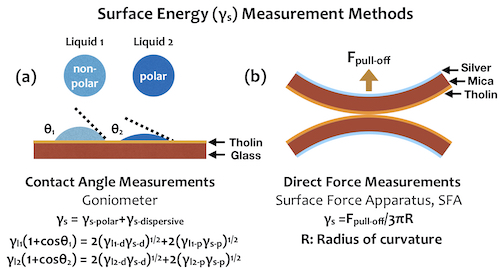
The surface energy of tholin is relatively high compared to common polymers, indicating its high cohesiveness. Thus the Titan haze particles are likely to coagulate easily to form bigger particles, while the surface sand could be hard to be mobilized by the wind because of the high interparticle cohesion. The high surface energy of tholins also makes them good cloud condensation nuclei (CCN) for most hydrocarbon and nitriles condensates in Titan’s atmosphere (Yu Y. et al., in prep), which agrees well with Cassini observations of ice clouds (Anderson et al., 2018). Meanwhile, because of the low contact angle predicted between tholins and Titan’s lake end member species, it is unlikely to form a layer of floating aerosols on the surface of Titan’s lakes.
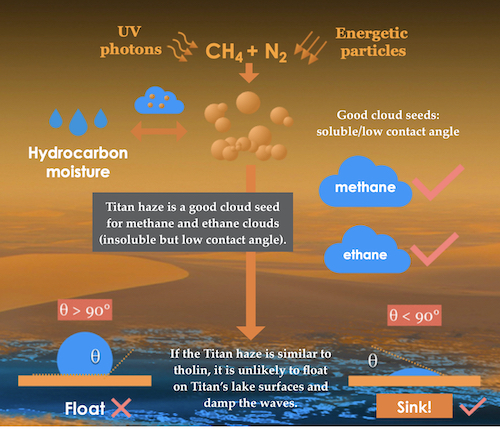
How to cite: Yu, X., Hörst, S., He, C., McGuiggan, P., Kristiansen, K., Zhang, X., Yu, Y., Li, J., and Garver, J.: Surface energy of the Titan aerosol analog "tholin": implications on cloud formation and aerosol-lake interactions, Europlanet Science Congress 2020, online, 21 Sep–9 Oct 2020, EPSC2020-621, https://doi.org/10.5194/epsc2020-621, 2020.
Remote sensing observations from Voyager 1’s InfraRed Interferometer Spectrometer (IRIS) and Cassini’s Composite InfraRed Spectrometer (CIRS) confirmed the presence of nitrile ice clouds in Titan’s stratosphere (Samuelson 1985, 1992; Khanna, R.K. et al., 1987; Samuelson et al., 1997, 2007; Coustenis, A. et al., 1999; Mayo and Samuelson, 2005; Anderson, C.M. et al., 2010, 2018a,b; Anderson and Samuelson, 2011). While individual gases in Titan’s stratosphere are expected to condense to form pure ices, some of these gases will enter altitude regions where they undergo simultaneous saturation, or co-condensation, and form a mixed ice. The infrared spectral features resulting from a mixed ice have their own unique spectral signatures that notably diverge from the weighted sum of the individual species, and must therefore be experimentally determined as functions of temperature and mixing ratio (Anderson and Samuelson, 2011; Anderson et al. 2018a,b).
The first observation of a co-condensate in Titan’s stratosphere was acquired by CIRS, which revealed a spectrally broad quasi-continuum ice emission feature with a spectral peak near 160 cm-1. Based on the altitude of the observed cloud top, combined with preliminary experimental efforts (Anderson and Samuelson, 2011), the co-condensate was determined to predominately contain cyanoacetylene (HC3N) and hydrogen cyanide (HCN). Here we present experimentally-measured absorbance spectra for the far-, mid-, and near-IR spectral regions (1.25 – 200 µm; 8000 – 50 cm-1), along with the corresponding optical constants, of HC3N-HCN co-condensed ices utilizing the SPECtroscopy of Titan-Related ice AnaLogs (SPECTRAL) Chamber (Anderson et al., 2018a). Various deposition temperatures and mixing ratios of mixed HC3N and HCN were systematically studied to quantify the chemical composition of Titan’s CIRS-observed 160 cm-1 stratospheric ice cloud emission feature.
How to cite: Ugelow, M. and Anderson, C.: Investigating the Chemical Composition of the CIRS-Observed 160 cm-1 Ice Cloud in Titan’s Stratosphere, Europlanet Science Congress 2020, online, 21 Sep–9 Oct 2020, EPSC2020-423, https://doi.org/10.5194/epsc2020-423, 2020.
Cassini CIRS observations of Titan’s south polar region in May 2013 revealed the presence of a benzene (C6H6) ice cloud in the stratosphere. During this period of southern fall, the descending branch of Titan’s global Hadley cell enriched the inventory of photochemically-produced hydrocarbon and nitrile species in the deep polar stratosphere. Additionally, strong cooling was observed, resulting in condensation at higher altitudes than normally found at other latitudes. Analysis of CIRS data indicates a cloud top near 280 km at the south pole, shifting lower in altitude with decreasing latitude, and an upper limit of ~1.5 μm for the equivalent radius of pure C6H6 ice particles [1].
We investigate the size and number of benzene (C6H6) cloud particles as a function of altitude using microphysics model simulations initialized with CIRS data and augmented by new laboratory measurements of C6H6 vapor pressures. The Community Aerosol and Radiation Model for Atmospheres (CARMA) simulates the microphysical evolution of aerosol particles in a column of atmosphere. The particles are modeled using discrete size bins. Cloud particles are created through heterogeneous nucleation using the haze particles as cloud condensation nuclei (CCN). Cloud particle formation and growth is controlled by the vapor pressure of C6H6. Existing laboratory measurements for the C6H6 sublimation vapor pressure do not cover temperatures below 184 K and are therefore insufficient to allow CARMA to reproduce the formation of the observed cloud system on Titan [2].
We have performed new experiments using the NASA Ames Atmospheric Chemistry Laboratory (ACL) to monitor the condensation of C6H6 in the IR and have determined, for the first time, the nucleation supersaturation and equilibrium vapor pressure of pure C6H6 at Titan-relevant temperatures (135–160 K). The experimental measurements of the vapor pressure of C6H6 we have acquired differ in slope and magnitude from the extrapolation of [3], which has previously been used by the Titan community. These new vapor pressure measurements indicate colder temperatures and higher pressures, and they are closer to the extrapolation calculated by [4]. Here we present new simulations conducted with CARMA using both the extrapolated values from [3] and those from [4] as well as the experimental vapor pressures to see their effect on the calculation.
We simulate the southern polar atmosphere in CARMA by initializing the model with a temperature/pressure profile from CIRS data at 87 S. All particles are transported vertically through sedimentation, eddy diffusion, and a vertical wind simulating Titan’s Hadley cell. The descending branch of the Hadley cell is included by calculating a downward vertical wind with a magnitude of 2.5 mm/s at 380 km, as indicated by the CIRS data. All particles are also subject to coagulation. While coagulation is an important process in growing the haze particle population, we have generally found that the number of cloud particles formed prove to be too few for efficient coalescence. Cloud particles are created through heterogeneous nucleation using the involatile particles as cloud condensation nuclei. Nucleation follows the classical theory – there is an energy barrier to efficient particle formation; this is calculated from the contact parameter between the C6H6 ice and tholin substrate; as the contact parameter approaches unity, the energy barrier goes to zero. Cloud particles then interact with the volatiles through condensational growth and evaporation. Our simulations show cloud particles begin to form at altitudes comparable to that derived from the CIRS data with a vertical profile extending down through Titan’s tropopause. The population of cloud particles grows from an effective radius ~0.5 μm near the cloud top to ~1.5 μm in the troposphere.
Funding for this project is provided through NASA CDAP.
[1] Vinatier et al. 2018, Icarus, 310, 89-104. [2] Barth 2017, Planet. Space Sci., 137, 20-31. [3] Fray & Schmitt 2009, Planet. Space Sci., 57, 2053-2080. [4] Jackowski 1974, J. Chem. Thermodynamics, 6,49-52.
How to cite: Barth, E. L., Dubois, D., Iraci, L., Salama, F., Vinatier, S., and Sciamma-O'Brien, E.: New Cold-Temperature Vapor Pressure Measurements Help Constrain the Microphysical Properties of Titan’s South Pole Benzene Cloud, Europlanet Science Congress 2020, online, 21 Sep–9 Oct 2020, EPSC2020-524, https://doi.org/10.5194/epsc2020-524, 2020.
Amongst the numerous achievements of the Cassini-Huygens mission, the exploration of the Titan environment has had an unprecedented impact on the knowledge of this planet-like satellite of Saturn. The next milestone is the Dragonfly mission selected for a launch in 2026 and an arrival on Titan in 2034 (Turtle et al. LPSC abstract 2019).
Now is the moment to bridge the gap between the end of the Cassini-Huygens measurements and the preparation of Dragonfly operations by prospecting on the work needed to take Titan’s science to the next level prior to DragonFly’s future discoveries. Those first remarks are generic for all possible Titan science; yet those apply particularly to Titan’s atmosphere (Hörst et al. JGR planets 2017). In this piece we address the need for innovative atmospheric modeling for Titan.
The present state of the art on Titan’s atmospheric modeling could be summarized as follows. On the one hand, global climate modeling for Titan helped to make sense of Titan’s atmospheric circulation on a planetary scale (Lebonnois et al. Icarus 2012, Lora et al. Icarus 2015). On the other hand, regional climate (“mesoscale”) modeling was employed to understand the dynamics of convective storms made of methane and hydrocarbons (Barth and Rafkin Icarus 2010) and atmospheric dynamics in the vicinity of lakes and seas (Rafkin and Soto, submitted arxiv 1904.00120). The two approaches are complementary. Maybe the best example of this is the demonstration that the direction of equatorial dunes can only be explained when the large-scale winds are combined with convective methane storms able to cause wind maxima close to the surface opposite to the GCM predictions and compliant with observed dune propagation (Charnay et al. Nature Geoscience 2015).
At the time of writing, no three-dimensional atmospheric model, suitable for the small scales and including complete physical packages (radiative transfer, cloud microphysics, etc), is available to resolve turbulence, convection and regional winds on Titan. Furthermore, assuming the Rafkin and collaborators’ model will soon be upgraded to those capabilities, having a diverse set of mesoscale models for Titan available is an asset for the community.
Why would a regional-scale and turbulence-resolving model for Titan be needed?
1/ To characterize turbulent motions and help to constrain the flight conditions for the Dragonfly mission and, more generally, to understand turbulent motions on Titan.
2/ To resolve the three-dimensional convective dynamics in Titan’s methane and hydrocarbon storms and elucidate how they form, develop and dissipate; to assess the role of those storms in the near-surface exchanges and the organic cycle.
3/ To characterize surface-atmosphere exchange of particles and organic matter, in particular aeolian processes and sediment transport shaping Titan’s surface and dunes as major organic reservoirs; to understand the dynamics and aeolian potential of dust storms and dust devils on Titan.
4/ To elucidate the possibility of mesoscale dynamical features on Titan: slope winds, sea breezes, gravity waves, etc… and how those mesoscale phenomena impact the global dynamics.
5/ To make available a modeling platform used in specific, targeted regions, in which to couple photochemical models of interest for organic matter studies.
Our team started to develop such a new atmospheric model for Titan and to propose it as a tool to the Titan community. We base our efforts on similar modeling tools developed for Mars (Spiga and Forget JGR planets 2009 ; Spiga et al. Nature Geoscience 2017) and Venus (Lefèvre et al. JGR planets 2017 & Icarus 2020).
Our initial idea for developing mesoscale models is simple: an atmospheric model comprises a dynamical core (hydrodynamical solver for the Navier Stokes equations) coupled with physical packages for sub-grid scale unresolved processes (radiative transfer, cloud microphysics); we take the latter out of a Titan GCM (here, the IPSL Titan GCM) and we borrow the former from the terrestrial mesoscale model Weather Research and Forecast (WRF, Skamarock et al. Journal of Computational Physics 2008). That way, both the Titan GCM providing initial and boundary conditions for wind, temperature, and chemical species and our newly-built Titan mesoscale model share similar physical packages, ensuring optimal consistency in the downscaling approach.
With such an admittedly ambitious program, which starting point could we adopt? Our experience with other planets is that the first applications shall be three-dimensional idealized simulations before the complete workflow for fully realistic simulations can be developed.
Modeling instabilities caused by wind shear in Titan’s lower stratosphere, to explain the unexpected wind minima experienced by the Huygens probe is a first example (Lefèvre et al. EPSC-DPS abstract 2019).
Another possibility explored here is to carry out large-eddy simulations for Titan’s near-surface turbulence. Those simulations are named as such because only the largest turbulent eddies are resolved / predicted by the model’s dynamics. Our prospect is, for instance, to evaluate the ability of dust devils to redistribute organic dust at the surface and in the atmosphere. Preliminary results show horizontally-organized turbulent structures (Figure 1), yet organized swirling motions are not yet reproduced at the time of writing.
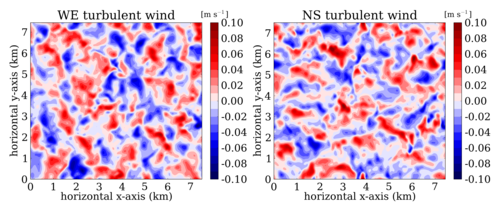
Figure 1 : Near-surface turbulent wind fields simulated by a prototype large-eddy simulation for Titan, using coupling of the adapted WRF dynamical core with the Titan physics from the IPSL Titan GCM.
The development of the model is currently ongoing ; the first test for mesoscale simulations with existing topography (Corlies et al. GRL 2017) will be in the region enclosing the Shangri-La dune field, the Dragonfly provisional landing site (Figure 2). The development of our modeling system makes it easy to update the surface thermophysical properties with new datasets arising for topography, albedo, thermal inertia.
Ideas for collaboration are very welcome following the presentation of this abstract.
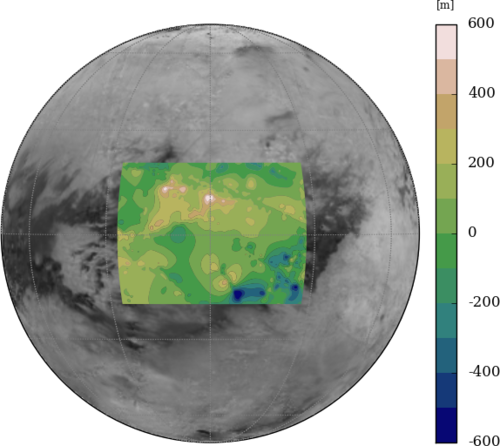
Figure 2 : An example of horizontal domain for mesoscale applications with our model, considered in the region of the Dragonfly landing site.
How to cite: Spiga, A., Lefèvre, M., Vatant d'Ollone, J., Lebonnois, S., Rodriguez, S., Chatain, A., Bonnefoy, L., and Lucas, A.: Developping a new model for mesoscale and large-eddy simulations of Titan's atmosphere, Europlanet Science Congress 2020, online, 21 Sep–9 Oct 2020, EPSC2020-286, https://doi.org/10.5194/epsc2020-286, 2020.
We investigate the spectral behavior of nine Titan impact craters in order to constrain their surface composition using Visual and Infrared Mapping Spectrometer (VIMS) data and a radiative transfer code (RT) [e.g. 1] in addition to emissivity data. Past studies have looked at the chemical composition of impact craters either by using qualitative comparisons between craters [e.g. 2;3] or by combining all craters into a single unit [4], rather than separating them by geographic location or degradation state. Here, we use a radiative transfer model to first estimate the atmospheric contribution to the data, then extract the surface albedos of the impact crater subunits, and finally constrain their surface composition by using a library of candidate Titan materials. Following the general characterization of the impact craters, we study two impact crater subunits, the ‘crater floor’ and the ‘ejecta blanket’. The results show that Titan’s mid-latitude plain craters: Afekan, Soi, and Forseti, in addition to Sinlap and Menrva are enriched in an OH-bearing constituent (likely water-ice) in an organic based mixture, while the equatorial dune craters: Selk, Ksa, Guabonito, and Santorini, appear to be purely composed of organic material (mainly unknown dune dark material). This follows the pattern seen in [4], where midlatitude alluvial fans, undifferentiated plains, and labyrinths have surface spectra consistent with a mixture of tholin-like spectral features and water ice-like spectral features, while the equatorial undifferentiated plains, hummocky terrains, dunes, and variable plains appear to have spectra similar to a dark material and tholin-like mixture in their very top layers. These observations also agree with the evolution scenario proposed by [3] wherein the impact cratering process produces a mixture of organic material and water-ice, which is later “cleaned” through fluvial erosion in the midlatitude plains. This cleaning process does not appear to operate in the equatorial dunes, which seem to be quickly covered by a thin layer of sand sediment (with the exception of the freshest crater on Titan, Sinlap). Thus, it appears that active processes are working to shape the surface of Titan, and it remains a dynamic world in the present day.
[1] Hirtzig, M., et al. (2013). Icarus, 226, 470–486; [2] Neish, C.D., et al. (2015), Geophys. Res. Lett. 42, 3746–3754; [3] Werynski, A., et al. (2019), Icarus, 321, 508-521; [4] Solomonidou, A., et al. (2018), J. Geophys. Res, 123, 2, 489-507
How to cite: Solomonidou, A., Neish, C., Coustenis, A., Malaska, M., Le Gall, A., Lopes, R., Werynski, A., Lawrence, K., Altobelli, N., Witasse, O., Schoenfeld, A., Matsoukas, C., Baziotis, I., and Drossart, P.: The chemical composition of impact craters on Titan, Europlanet Science Congress 2020, online, 21 Sep–9 Oct 2020, EPSC2020-7, https://doi.org/10.5194/epsc2020-7, 2020.
Titan is a complexe moon of Saturn, with dense atmosphere, hydrocarbon cycle, and water-ice crust. Titan was targeted by two major space missions: Voyager and Cassini, and has been the subject of many studies. Lakes and seas of liquid hydrocarbons were discovered
by Cassini's RADAR in Titan's polar regions [15, 14]. This instrument also detected on equatorial regions geomorphological structures related to the presence of liquid, like fluvial valleys incised in the bedrock, and alluvial fans [8, 3]. The existence of evaporitic terrains where also suggested [1, 4, 9], often in place of paleo-sea [12]. Water ice signal is not present everywhere on Titan, contrary to other icy moon of Saturn and Jupiter. It was detected with Cassini's VIMS instrument in Titan's dark region, often at the transition between a dark and bright unit, and mixed with a darkening material [11, 13]. Ref. [6] also highlighted an equatorial corridor of exposed water-ice using a principal component analysis (PCA) with VIMS, showing on a large scale terrains with low and high water ice content.
We accentuate our study on Titan's river bed, where the erosion due to liquid hydrocarbon can reveals the bedrock, and where we can have clues on the sediment transport. Here we propose a study of the water ice signal distribution in Xanadu and Tui regio, where we have channels [8] and paleo-seas of hydrocarbures [12].
We focused on 2 radar bright channels [8], and the surrounding areas. The channels are located at the south of Xanadu, directly exiting the mountains. They are at the north of the evaporitic region Tui
Regio [10], and form dry dendritic fluvial valleys [7], with a width up to 8~km. We apply a radiative transfer analysis to retrieve the surface albedo of 2 VIMS cubes located in our area of study : 1590648776_1, and 1809727868_1.
We establish a criteria δ representing the intensity of the water-ice signature, based on wavelength ratios and means of the surface albedo significant for the identification of the water-ice spectrum. They are detailed in Tab. 1. Those ratio and mean are normalized with respect to themselves. Then, they are added if the expected value indicating a high water ice signal is high or >1, and subtracted otherwise. We then have a range of values going from δ = -4 for no water ice signature, and δ = 1 for a high water ice signal. The results of this multicriteria analysis are in Fig. 1 and 2. An example of the different spectra for a low and high δ are given is Fig.3.
|
Wavelength ratio |
Expected value if water-ice signature |
| 1.58/1.28 | < 1 |
| 2.03/1.28 | < 1 |
| 2.03/1.58 | < 1 |
| 2.7/2.8 | high |
| 4.85 - 5.1µm | low |
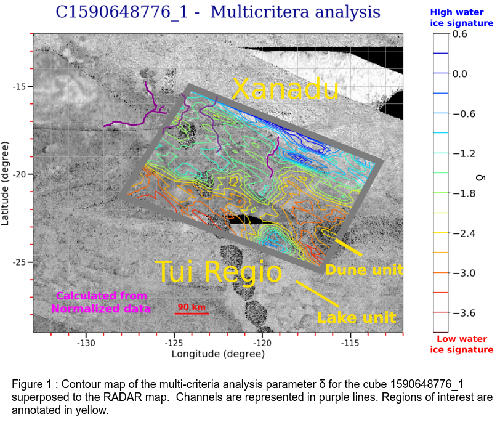
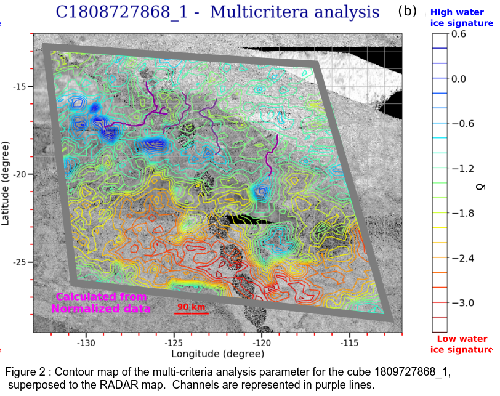
The radiative transfer analysis highlighted areas of high water-ice signal on Xanadu mountains, and also at the end of the dry channels, corresponding to potential deltas or alluvial fans, supporting [2] and [7] hypothesis of sediment transport from the mountains of Xanadu to downstream of the channels. The ice signal is lower inside the channels, perhaps due to their sizes, smaller than the spatial resolution of a pixel. The Fig. 3 shows that water ice lower the surface albedo.
This combined analysis also shows a gradient of low water-ice signal perfectly superposed to Tui Regio in the RADAR map. This gradient could correspond to the decreasing thickness from the center to the border of the evaporite layer of Tui Regio, as suggested by [5].
Detailed analysis of the retrieved albedo could bring further information on the composition of those terrains if the error bars are low enough. A map of the inversion of the surface signal allows us to have a finer vision than just an analysis of the I/F. With the parameter δ, we have better contrasts, and a direct appreciation of the strength of the water-ice signature.
Acknowledgements
The present research was supported by the Programme National de Planétologie (PNP) of CNRS-INSU co-funded by CNES, and also partially supported by the French HPC Center ROMEO, the Région Grand-Est and the University of Reims Champagne-Ardenne.
References
[1] J. W. Barnes et al., Organic sedimentary deposits in Titan’s dry lakebeds: Probable evaporite. Icarus, 216:136–140, November 2011.
[2] Jason W. Barnes et al., Near-infrared spectral mapping of Titan’s mountains and channels. Journal of Geophysical Research (Planets), 112(E11):E11006, Nov 2007.
[3] S.P.D. Birch et al., Alluvial fan morphology, distribution and formation on titan. Icarus, 270:238 – 247, 2016. Titan’s Surface and Atmosphere.
[4] D. Cordier et al., On the chemical composition of Titan’s dry lakebed evaporites. Icarus, 226(2):1431–1437, 2013.
[5] D. Cordier et al., Structure of titan’s evaporites. Icarus, 270:41–56, may 2016.
[6] Caitlin A. Griffith et al., A corridor of exposed ice-rich bedrock across Titan’s tropical region. Nat. Astron., page 343, Apr 2019.
[7] M. H. Langhans et al., Titan’s fluvial valleys: Morphology, distribution, and spectral properties. Planet. Space Sci., 60(1):34–51, Jan 2012.
[8] A. Le Gall et al., Radar-bright channels on Titan. Icarus, 207:948–958, June 2010.
[9] S. M. MacKenzie et al., Evidence of Titan’s climate history from evaporite distribution. Icarus, 243:191–207, November 2014.
[10] Shannon MacKenzie and Jason Barnes. Compositional Similarities and Distinctions between Titan’s Evaporitic Terrains. The Astrophysical Journal, 821(1):0, 2016.
[11] T. B. McCord et al., Composition of Titan’s surface from Cassini VIMS. Planet. Space Sci., 54(15):1524–1539, Dec 2006.
[12] Jeffrey M. Moore and Alan D. Howard. Are the basins of titan’s hotei regio and tui regio sites of former low latitude seas ? Geophysical Research Letters, 37(22), 2010.
[13] Laurence A. Soderblom et al., Correlations between cassini vims spectra and radar sar images: Implications for titan’s surface composition and the character of the huygens probe landing site. Planetary and Space Science, 55(13):2025 – 2036, 2007. Titan as seen from Huygens.
[14] K. Stephan et al., Specular reflection on Titan: Liquids in Kraken Mare. Geophysical Research Letters, 37:L07104, April 2010.
[15] E. R. Stofan et al.,The lakes of Titan. Nature, 445:61–64, January 2007.
How to cite: Coutelier, M., Cordier, D., Rannou, P., and Seignovert, B.: Distribution and intensity of water ice signature in South Xanadu and Tui Regio, Europlanet Science Congress 2020, online, 21 Sep–9 Oct 2020, EPSC2020-188, https://doi.org/10.5194/epsc2020-188, 2020.
Introduction
During T58 flyby (2009), Cassini VIMS recorded 4 spectral cubes containing a very unusual signature with a very high I/F infrared peak around 5 µm in a specular geometry [1]. This observation, located on a radar smooth area [2] was the first confirmation of the presence of large hydrocarbon liquids in Titan’s North Pole. Between 2010 and 2014, a dozen of similar specular signatures were recorded by VIMS above different lakes and mares [3-6]. Modeling the shape of these signals and their spread on the surface, provide new information about the methane-ethane ratio [1], the refractive index of the lakes [3], the transmission spectrum of Titan’s atmosphere [5] and even the roughness of the lake and the height of waves [4, 6]. More recently, off-specular observations also provided new constraints on wetted surfaces [7] and tidal/wind waves [8].
Until now, detection of the specular points in the VIMS dataset were conducted manually on cubes recorded above the North Pole containing a significantly high signal at 5 µm. The purpose of this study is to generalize specular point detections and create a global database of all specular pixels across the entire mission to map their spatial distribution and their spectral variability.
Method
A specular point corresponds to the reflection of a point light source on a perfect flat mirror which happens when the incidence and emergence angles are equal and aligned. More generally, any surface will produce a peak of intensity at the specular point related to its local surface properties. Unfortunately, the location of the specular point on a sphere is not trivial to determine but can be reduce to a quartic polynomial on the specular angle :
is the radius of planet,
the distance to the spacecraft and
the phase angle. For each Titan flyby, we use the SpiceyPy toolkit [9] to extract the position of the Sun as function of Cassini's location. Then, for all VIMS cubes taken by Cassini, we check if the specular point is within the pixel footprint (i.e., the instantaneous field of view, IFOV) when it was acquired.
Results
All the specular pixels are considered, independently of their spectral signature. Between 2004 and 2017, we found 7751 cubes containing at least one specular point. Fig. 1 summarizes the location of all the specular pixels observed around the northern latitudes. We determined 238 specular points above known lakes and 176 specular points have an I/F peak larger than 0.5 in the 5 µm window [10]. Most of the pixels with a strong peak at 5 µm are located on Kraken Mare, close to Punga and Jingpo lacus and in lake district.
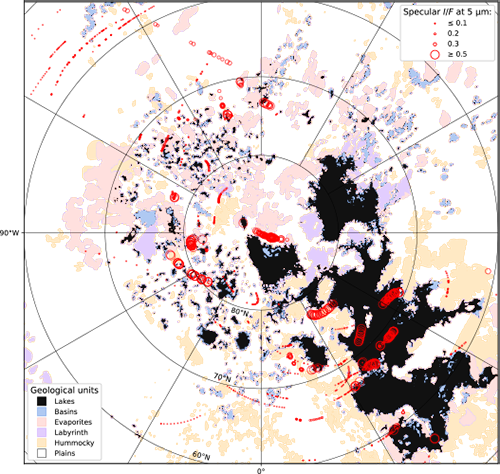
Fig. 1: Titan's North Pole with specular point locations (red circles) contained within VIMS IFOVs. The size of the circle is proportional to the mean I/F spectra at 5 µm. Geological units from [11, 12].
We notice that many specular pixels that do not present a strong peak at 5 µm are located on plains. This confirms that the presence of a 5 µm specular peak is highly correlated with the presence of liquid lakes or wetted surfaces.
Conclusions
Tracking specular reflection on the surface of Titan provides many opportunities to probe its local surface properties. We show that approximately 30% of the VIMS cubes contain at least one pixel in a specular geometry. All previously reported specular points [1, 3-6] are included in our database. This represent a large collection of spectra that could help us to better determine the surface and atmospheric properties, the lake content and behavior and bring new insights on the morphology and composition of the surrounding geological units.
Acknowledgments
This work was performed at the Jet Propulsion Laboratory, California Institute of Technology, under contract to NASA. Raw data used in the study are available on the Planetary Data System (pds-imaging.jpl.nasa.gov/volumes/vims.html). Calibrated data are also available on the Nantes Cassini VIMS Data Portal (vims.univ-nantes.fr).
References
[1] Stephan et al. (2010) - doi:10.1029/2009GL042312
[2] Stofan et al. (2007) - doi:10.1038/nature05438
[3] Soderblom et al. (2012) - doi:10.1016/j.icarus.2012.05.030
[4] Barnes et al. (2011) - doi:10.1016/j.icarus.2010.09.022
[5] Barnes et al. (2013) - doi:10.1088/0004-637X/777/2/161
[6] Barnes et al. (2014) - doi:10.1186/s13535-014-0003-4
[7] Dhingra et al. (2020) - doi:10.3847/PSJ/ab9c2b
[8] Heslar et al. (2020) - under review
[9] Annex et al. (2020) - doi:10.21105/joss.02050
[10] Sotin et al. (2005) - doi:10.1038/nature03596
[11] MacKenzie et al. (2014) - doi:10.1016/j.icarus.2014.08.022
[12] Lopes et al. (2019) - doi:10.1038/s41550-019-0917-6
How to cite: Seignovert, B., Sotin, C., Lawrence, K. J., and Heslar, M.: Mapping VIMS specular reflections on Titan’s surface during the Cassini mission, Europlanet Science Congress 2020, online, 21 Sep–9 Oct 2020, EPSC2020-340, https://doi.org/10.5194/epsc2020-340, 2020.
Introduction
Titan, the biggest satellite of Saturn, is the only satellite of the solar system possessing a dense atmosphere. This atmosphere, whose composition
is dominated by nitrogen and methane, habors a complexe chemistry initiated by the photolysis of these species. Among a plethora of molecules, ethane dominates, in quantity, the products of the atmospheric chemistry. Since the Voyager flyby, the existence of liquid bodies at the
surface of Titan has been suspected. Thanks to its radar, which had the capability of imaging the surface through the atmosphere
opaque to visible light, the Cassini orbiter instruments have revealed a collection of dark features dotting the polar regions
(Stofan et al. 2007, Turtle et al., 2009). These geomorphological characteristics are interpreted as lakes or seas (depending on their size)
of liquid hydrocarbons. These structures were found at both poles and involve diameters up to more than hundreds of kilometers.
Recently, Titan's surface altimetry investigations have shown that several Maria share the same equipotential for their free surface
(Corlies et al., 2017, Hayes et al., 2017). These new measurements suggest the existence of some local subsurface connectivity between
liquid bodies. The concept of an alkanofer, analog of terrestrial aquifer, has been already proposed in the literature
(Mousis et al. 2014, Mousis et al. 2016). Such an alkanofer consists of a mixture of liquid hydrocarbons trapped in a porous icy crust.
On the Earth, beside already mentioned aquifers, alkanofers also exist and are called hydrocarbon reservoirs, they contain
petroleum and gases. For many decades, field measurements have revealed a wide range of compositional variation in these reservoirs. These variations
are most of the time vertical (Metcalfe et al. 1988), while horizontal cases are also observed. In general, the lightest hydrocarbons are found at
the top of the reservoir, while the heaviest molecules are buried at the bottom of the system.
In the context of Titan, one may wonder whether such a chemical stratification could appear within an alkanofer mainly composed by
a liquid mixture of methane, ethane and dissolved nitrogen. This question is important, specifically
for the ``problem of missing ethane'' (Gilliam & Lerman, 2016); in addition, investigations concerning this system are also related to the Titan's
hydrological cycle (Horvath et al., 2016). Finally, and more generally, the nature, the amplitude and the temporality of exchanges between Titan's
interior and its atmosphere is a very important ``cold case'' for which any advanced is welcome (Nixon et al., 2018).
A Model of Chemical Stratification of the Possible Alkanofer
Since the convection is often inhibited in hydrocarbon reservoirs, the transport process at work is based on diffusion processes.
In the general case, the evolution of the mole fraction xi of a species i with z, the depth in the alkanofer, is governed by two
equations (Bird et al., 1960, Ghorayeb & Firoozabadi 2000)
The first term of Eq. 1 represents the usual molecular fickean diffusion, the second term the barodiffusion due to the gradient of pressure, and the third one takes account for the thermodiffusion caused by the temperature gradient. Usual notation has been used: fi is the fugacity, R the gas constant, Vi the partial molar volume and Mi the molecular weight of species i. The density of the liquid is ρliq, while kT,ij denotes the thermal diffusion ratio. Obviously, Eq. 2 is the hydrostatic equilibrium of Titan's crust, where the density ρeff takes into account the weight of the wate ice Ih.
Since the evaluation of kT,ij is not straightforward, we have chosen, in a first approach, to neglect the temperature effect.
This preliminary model is then a Titan's isothermal crust made of a N2+CH4+C2H6 liquid mixture trapped in a Ih-ice matrix. The properties
of the liquid mixture is described by the PC-SAFT equation of state. The results for an isothermal crust at T= 90 K are plotted in
Fig. 1. Not surprisingly, heaviest compounds have their mole fractions increasing down to approximately -35 km. Below this depth,
the separation beween nitrogen and hydrocarbons was not a priori expected. In this presentation we will discuss the existence of liquids
at high depth and the possible explanation for the mentioned separation.
In a second step, we will present our non-isothermal model which is based on: (1) a reconstruction of the geophysical temperature gradient,
(2) a derivation of the thermal diffusion coefficient from the equation of state PC-SAFT. The model of interior structure relies on a non-convecting
crust (Nimmo & Bills, 2010) for which we included hydrostatic equilibrium, energy conservation and energy flux equations (Sohl et al., 2014).
The temperature law produced by this model is used as an input of a ``chemical model'' based on Eq. 1 and 2, where
kT,ij 's are derived from PC-SAFT, like we did for other quantities: fi,Vi and ρliq.
Our presentation is complemented by a detailed discussion of involved timescales related to Titan's alkanofers formation. We also consider the role of such
alkanofers in the release of geologic argon into the atmosphere.
References
Bird, Stewart and Lightfoot, 1960, Transport Phenomena, John Wiley and Sons, New York.
Corlies, Hayes, Birch, Lorenz, R. Stiles, Kirk, Poggiali, Zebker, Iess, 2017, GRL, 44, 11.
Ghorayeb, Firoozabadi, 2000, AICheJ, 46, 883.
Gilliam, & Lerman, A. 2016, Icarus, 275, 252.
Hayes, Birch, Dietrich, Howard, Kirk, Poggiali, Mastrogiuseppe, Michaelides, Corlies, Moore, Malaska, Mitchell, Lorenz, Wood, 2017, GRL, 44, 11
Horvath, Andrews-Hanna, Newman, Mitchell, Stiles, 2016, Icarus, 277, 103
Metcalfe, Vogel, Morris, R. W. 1988, SPE.
Mousis, Choukroun, Lunine, Sotin, 2014, Icarus, 239, 39.
Mousis, Lunine, Hayes, Hofgartner, J. D., Icarus, 270, 37. Nimmo, F., & Bills, B. G. 2010, Icarus, 208, 896.
Nixon, Lorenz, Achterberg, et al. 2018, PSS, 155, 50.
Sohl, Solomonidou, Wagner, et al. 2014, JGR, 119, 1013.
Stofan, Elachi, Lunine, et al. 2007, Nature, 445, 61
Turtle, Perry, McEwen, et al. 2009, GRL, 36, 2204
How to cite: Cordier, D. and Bonhommeau, D. A.: Chemical properties of the possible Titan's alkanofer, Europlanet Science Congress 2020, online, 21 Sep–9 Oct 2020, EPSC2020-308, https://doi.org/10.5194/epsc2020-308, 2020.
Abstract
The abundance of methane and 40Ar in Titan's atmosphere points to the exchange processes between the surface and the deep interior. Here, we study heat and water transport through Titan's high-pressure (HP) ice layer using a two-phase model of solid ice-liquid water mixture. Our results show that melting may occur at the interface with silicates and that the generated liquids then ascend through the layer before reaching the ocean. This process may facilitate the transport of volatiles from the core to the ocean. We also derive scaling laws to determine the occurrence of bottom melting. Using Cassini data and reasonable values of viscosity and heat flux, we predict that exchange processes through Titan's HP ice layer might be ongoing.
Introduction
Titan is likely differentiated into a hydrated silicates core [4] and a hydrosphere composed of a high-pressure (HP) ice layer, an ocean, and an ice I crust. The presence of an ocean was suggested based on the interpretation of (i) measurements of Schumann-like resonance [3], (ii) Cassini-inferred large value of k2 [5], and (iii) the large measured value of obliquity [2].
Several observations and their interpretations also point to exchange processes between the deep interior and the atmosphere, such as the large amount of 40Ar [9] and methane [1] and the observed 15N/14N isotope ratio [8]. Here, we study the dynamics of Titan's HP ice layer to investigate its permeability for volatiles transport between the silicate core and the ocean.
Numerical model
We solve the two-phase mixture equations [10] for the mixture of two coexisting phases - solid ice and liquid water. In this approach, the amount of water is described by porosity φ that is defined as a volume fraction of water in the mixture. We use the open source Finite Element Method library FEniCS [7]. For more details, see [6].
Results
Figure 1 shows the difference of temperature T from the melting temperature Tm (top) and the corresponding porosity φ (bottom) for the reference simulation. We observe that: (i) a layer of temperate ice (T=Tm, dark red) is established at the ocean interface, (ii) melt appears in the upwelling plumes and the top temperate layer from where it is extracted into the ocean, (iii) some melt may also be generated at the silicates interface, (iv) the amount of liquid water (porosity) is small (≤ few percent). Being less dense than the HP ice, the generated water provides additional buoyancy that promotes the ascent of hot temperate plumes and the extraction of most of the water produced at the silicates interface. The main model parameters (HP ice layer thickness H, HP ice viscosity μ, incoming silicates heat flux qs) determine the convection and melt generation pattern.
The occurrence of melt at the silicates interface is determined by the efficiency of HP ice convection which is characterized by the Rayleigh number. To describe the thermal state of this interface when there is no melt (T<Tm), we perform thermal boundary layer (TBL) analysis that relates the hot TBL thickness with the Rayleigh number. We then derive an expression for the critical silicates heat flux for bottom melting which is shown in Figure 2. If, for given H and μ, the silicates heat flux qs is smaller than the critical value qsc, temperature at the silicates interface is below the melting temperature and no melt is produced. On the other hand, if the silicates heat flux is larger than the critical value, melting occurs at the interface. Note that the smaller the viscosity (leading to more efficient heat transfer by solid state convection), the larger the heat flux that is necessary for bottom melting for a given HP ice layer thickness and vice versa.
The light yellow rectangle in Figure 2 shows the estimated present day value of the heat flux coming out of the silicate core [6]. Following [2] who predict the ice I crust thickness smaller than 100 km and assuming pure H2O hydrosphere, the present day HP ice layer thickness is less than 140 km (determined by the ocean adiabat). For this value, melt is predicted at the silicates interface if the ice viscosity is 1015 Pa s or larger (Figure 2).
Conclusions
We investigated the dynamics of Titan's HP ice layer by solving the problem of two-phase thermal convection of solid ice and liquid water mixture. We showed that melting at the silicates interface depends on the ice viscosity, the HP ice layer thickness and the incoming heat flux and we found a corresponding scaling law for the critical silicates heat flux for bottom melting. If melting occurs at the silicates interface, argon, nitrogen and other volatiles coming out of the silicates could be dissolved in water, advected through the HP ice layer, and extracted into the ocean. Based on Cassini observations and reasonable values of HP ice viscosity, we predict that exchange processes through Titan's deep HP ice layer might be ongoing.
Acknowledgements
KK received funding from the Czech Science Foundation through project No. 19-10809S and from the Charles University Research program No. UNCE/SCI/023. CS acknowledges support by the NASA Astrobiology Institute through project `Habitability of Hydrocarbon Worlds: Titan and Beyond' (17-NAI8_2-0017). Part of this work was carried out at the Jet Propulsion Laboratory, California Institute of Technology, under a contract with the National Aeronautics and Space Administration.
References
[1] Atreya et al. (2006), PSS, 54, 1177-1187.
[2] Baland et al. (2014), Icarus, 237, 29-41.
[3] Beghin et al. (2012), Icarus, 218, 1028-1042.
[4] Castillo-Rogez & Lunine (2010), GRL, 37, L20205.
[5] Iess et al. (2012), Science, 337, 457-459.
[6] Kalousova & Sotin (2020), EPSL, accepted.
[7] Logg et al. (2012), The FEniCS Book.
[8] Miller et al. (2019), Astrophys. J., 871.
[9] Niemann et al. (2010), JGR, 115, E12006.
[10] Soucek et al. (2014), GAFD, 108, 639-666.
How to cite: Kalousova, K. and Sotin, C.: Dynamics of Titan's high-pressure ice layer, Europlanet Science Congress 2020, online, 21 Sep–9 Oct 2020, EPSC2020-82, https://doi.org/10.5194/epsc2020-82, 2020.
Please decide on your access
Please use the buttons below to download the presentation materials or to visit the external website where the presentation is linked. Regarding the external link, please note that Copernicus Meetings cannot accept any liability for the content and the website you will visit.
Forward to presentation link
You are going to open an external link to the presentation as indicated by the authors. Copernicus Meetings cannot accept any liability for the content and the website you will visit.
We are sorry, but presentations are only available for users who registered for the conference. Thank you.

